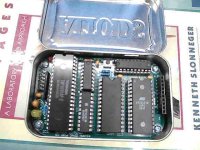syzygy
Veteran Member
For some reason, I had an interest in playing with an 8085. Nothing too serious, just enough to capture the flavor of those past days. I was looking for a minimal system and some minimal effort, because this was strictly for S & G.
I looked into a minimax8085 and an altaids8085. Both looked interesting and I went with the latter. Here, I thought I would share my first impressions in case anyone else is interested.
I bought a bare-board, which was a pleasure to fill. Everything is through hole and the silk screening makes it all so easy.
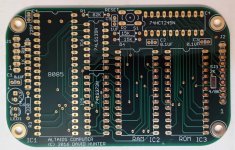
I had to get some parts but I also had some parts. Everything went well.
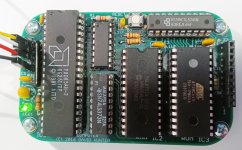
I used an FTDI USB-serial board and a separate power supply. As per the article and examples, I used TeraTerm to communicate; which I was already familiar with.
Powering up was an "oh yeah!" moment.
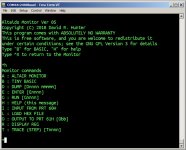
As you can see, there is a nice little collection of software included (I burned the .hex from the zip file, into the eprom).
So, at this point, I figured I needed to flash an LED and I needed to write some kind of a Tiny Basic program - the author wrote a variant of Palo Alto Tiny Basic.
I don't know if I have ever written a program in any version of any Tiny Basic, so I was just trying to get something...anything. In a little bit, I had a "guess the number" game.
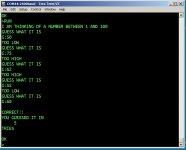
You can save and retrieve your programs (XMODEM). You can also just send the file and watch the 2400 Baud keypresses which is entertaining - for a bit.
I did manage to flash an LED, but I really need a simple latch like an ls175 (e.g, the article example) and I couldn't find one in my boxes, but I managed to kludge something together using an ls373 that worked, more or less. The schematic shows clearly how he decodes a WR signal (there are two ports decoded (I/O) and 9 pins taken out on the board.
So, all in all, I think that it is pretty nifty piece of work and a relatively inexpensive way of playing with an 8085. I can foresee a few weekend projects with this little board in my future. If you are interested, by all means, check it out.
I looked into a minimax8085 and an altaids8085. Both looked interesting and I went with the latter. Here, I thought I would share my first impressions in case anyone else is interested.
I bought a bare-board, which was a pleasure to fill. Everything is through hole and the silk screening makes it all so easy.

I had to get some parts but I also had some parts. Everything went well.

I used an FTDI USB-serial board and a separate power supply. As per the article and examples, I used TeraTerm to communicate; which I was already familiar with.
Powering up was an "oh yeah!" moment.

As you can see, there is a nice little collection of software included (I burned the .hex from the zip file, into the eprom).
So, at this point, I figured I needed to flash an LED and I needed to write some kind of a Tiny Basic program - the author wrote a variant of Palo Alto Tiny Basic.
I don't know if I have ever written a program in any version of any Tiny Basic, so I was just trying to get something...anything. In a little bit, I had a "guess the number" game.

You can save and retrieve your programs (XMODEM). You can also just send the file and watch the 2400 Baud keypresses which is entertaining - for a bit.
I did manage to flash an LED, but I really need a simple latch like an ls175 (e.g, the article example) and I couldn't find one in my boxes, but I managed to kludge something together using an ls373 that worked, more or less. The schematic shows clearly how he decodes a WR signal (there are two ports decoded (I/O) and 9 pins taken out on the board.
So, all in all, I think that it is pretty nifty piece of work and a relatively inexpensive way of playing with an 8085. I can foresee a few weekend projects with this little board in my future. If you are interested, by all means, check it out.

